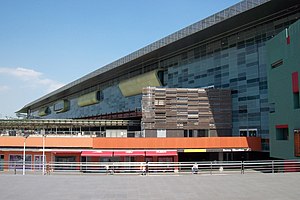
Back محطة روما تيبورتينا ARZ Bahnhof Roma Tiburtina German Estación de Roma Tiburtina Spanish ایستگاه راهآهن رم تیبورتینا Persian Gare de Rome-Tiburtina French Estación de Roma Tiburtina Galician Stazione di Roma Tiburtina Hungarian Stazione di Roma Tiburtina Italian ローマ・ティブルティーナ駅 Japanese 로마 티부르티나역 Korean
Roma Tiburtina | |||||||
|---|---|---|---|---|---|---|---|
 | |||||||
| General information | |||||||
| Location | Piazzale Stazione Tiburtina 00100 Roma RM Italy | ||||||
| Coordinates | 41°54′37″N 12°31′51″E / 41.91028°N 12.53083°E, | ||||||
| Owned by | Rete Ferroviaria Italiana | ||||||
| Operated by | Grandi Stazioni | ||||||
| Line(s) | Florence–Rome (traditional) Rome–Florence (high-speed) Rome–Naples (high-speed) Rome–Pescara Rome–Ancona | ||||||
| Distance | 4.5 km (2.8 mi) from Roma Termini | ||||||
| Platforms | 20[1] | ||||||
| Connections |
| ||||||
| Construction | |||||||
| Architect | Paolo Desideri (2011 building) [1] | ||||||
| History | |||||||
| Opened | 1866 | ||||||
| Rebuilt | 28 November 2011 | ||||||
| Electrified | 3,000 V | ||||||
| |||||||
Roma Tiburtina is the second largest railway station in Rome, after Roma Termini. Located in the north-eastern part of the city, it was originally constructed during the 1860s as a terminal station. In recent years, the station has been redeveloped to better serve as a hub for the Italian high-speed rail services. The station is connected to Rome's Metro line B at Tiburtina metro station, as well as to local bus services via an adjacent bus depot while private vehicle users are provided with more than 100,000 spaces across multiple on-site car parks.
Roma Tiburtina originally opened in 1866, only three years after the first (temporary) Roma Termini. It was originally known as Portonaccio station, but all usage of this name has since been depreciated. During the 1930s, work was undertaken to expand the station, this included the development of a new main building. A rebuild was undertaken shortly after the end of the Second World War as a result of damage sustained from aerial bombing missions. During 1990, an adjoining metro station was opened, providing further means of local transit for passengers. Since the late 1990s, Roma Tiburtina station has been managed by Grandi Stazioni, a wholly owned entity of the Italian state railway operator Ferrovie dello Stato Italiane.
Between 2007 and 2011, Roma Tiburtina was subject to an extensive redevelopment programme, during which much of the original station building and infrastructure were demolished and replaced, and new on-site facilities established. A major advantage of the redesigned station in terms of high-speed services is that it is a through station, meaning trains travelling from Turin/Milan to Naples/Salerno do not have any need to turn around. Officially inaugurated in November 2011, the new facility is dedicated to the traditional regional trains and to the high-speed rail services on the Milan-Naples line. The new station was projected to reach a daily ridership of over 45,000 by 2015.[2][3][4]
The station is currently served by 500 trains and 140,000 passenger transits per day (51 million users per year).[5]
- ^ a b "Tiburtina, via alla nuova stazione il primo hub per l'Alta velocità" [Tiburtina, a new station for the new High Speed hub]. la Repubblica (in Italian). Rome. 28 November 2011. Retrieved 28 November 2011.
- ^ "Roma Tiburtina (quasi) completa" [Rome Tiburtina (semi) complete]. CityRailways (in Italian). 28 November 2011. Retrieved 2 September 2017.
- ^ Fulloni, Alessandro (28 November 2011). "Tiburtina, 140 treni al giorno per l'Alta Velocità: 330 milioni di costi, 20 binari e 50mila mq" [Tiburtina, 140 trains per day for High Speed: 330 million cost, 20 tracks and 50 thousand square meters]. Corriere della Sera (in Italian). Milan. Retrieved 3 September 2017.
- ^ "Roma Tiburtina Railway Station, Rome". RailwayTechnology. 4 March 2012. Retrieved 28 June 2024.
- ^ "Rome Tiburtina Station". Rome: Ferrovie dello Stato Italiane. Retrieved 28 June 2024.
